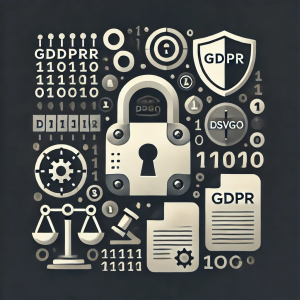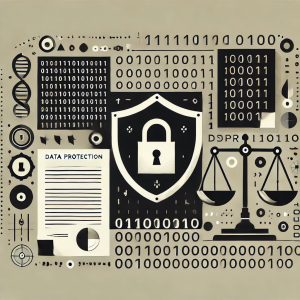The General Data Protection Regulation (GDPR; german: DSVGO) is a term that most people have heard of, but many aren’t entirely sure what it entails. Since its implementation in May 2018, it has reshaped how businesses and organizations handle personal data. But what exactly is the GDPR, where does it apply, and why does it often spark debates? This article will break it down in simple terms.
The Origin of the GDPR: Why was it introduced?
The GDPR was created by the European Union (EU) to unify data protection standards across Europe. Before its introduction, each EU member state had its own set of data protection laws, creating a compliance maze for companies – especially those operating in multiple countries. Meanwhile, the old regulations simply couldn´t keep pace with the explosion of personal data fueled by rapid technological advancement.
The main goals of the GDPR are to improve the protection of personal data and to ensure its free flow within the EU. It empowers individuals with greater control over how their data is used while holding companies accountable for data processing practices. In essence; it´s the EU´s way of saying: We see your data-hungry algorithms, and we raise your transparency and accountability.
Where Does the GDPR apply?
The GDPR applies to all 27 EU member states – but don´t think that means it stops at Europe´s borders. If your organization processes the personal data of EU residents, you´re in GDRP territory, no matter where your company is based. Whether you are a Silicone Valley tech giant or a small retailer in Australia, if you`re targeting EU customers or tracking their behavior (yes, cookies count), the GDPR has something to say about it.
This global reach has made the GDPR a international benchmark for data protection worldwide. Many countries have updated their own data privacy laws to align with the GDPR, recognizing its importance in serving the European market.
If you want to find out if the GDPR is applicable to your company, check out my 5-Step GDPR Applicability Checklist for Companies.
The Core Principles of the GDPR

The GDPR is built on six fundamental principles that guide the handling of personal data:
- Lawfulness, Fairness, and Transparency: Data must be processed in a lawful, fair, and transparent manner.
- Purpose Limitation: Data can only be collected for specified, explicit, and legitimate purposes.
- Data Minimization: Only the data necessary for the stated purpose should be collected.
- Accuracy: Data must be kept accurate and up-to-date.
- Storage Limitation: Data should not be stored longer than necessary for the intended purpose.
- Integrity and Confidentiality: Data must be processed securely to protect against unauthorized access or breaches.
These principles ensure that data processing respects individuals’ rights while maintaining security and accountability.

Challenges of the GDPR
While the GDPR has become the gold standard for data protection, businesses quickly learned it´s no walk in the park. Here´s where the headaches begin:
- It´s Complicated: For small and medium-sized businesses, understanding and implementing GDPR requirements can be overwhelming. The rules are detailed and often require legal expertise to interpret.
- It´s Expensive: Achieving GDPR compliance can involve significant costs, from updating IT systems to hiring data protection officers (DPOs).
- The “Wait-Does this apply to us?” Problem: Non-EU businesses often struggle to understand how the GDPR applies to them. Many feel unprepared for the steep fines that come with non-compliance.
- Grey Areas Galore: Some parts of the GDPR, such as the definition of “legitimate interest,” can be open to interpretation. This has led to uncertainty and varying enforcement practices.
- Who´s Watching the Small Fish: While large tech companies have faced significant fines, smaller organizations sometimes escape scrutiny due to limited enforcement resources.
The GDPRs Impact on Artificial Intelligence
Nowhere are the GDPR’s challenges more visible than in the world of Artificial Intelligence (AI). AI thrives on data—lots of it. That’s what makes machine learning models so powerful: the more data they consume, the smarter they get. But the GDPR’s principles, like data minimization and purpose limitation, seem tailor-made to make AI developers squirm.
AI systems often rely on massive datasets to perform effectively. But under GDPR, you can’t just collect everything and hope it comes in handy later. Organizations need to justify every data point they gather—and ensure it’s only used for specific purposes. That’s a tough pill to swallow for companies used to feeding their algorithms everything under the sun.
Then there’s the issue of transparency. Many AI systems, especially those using deep learning, operate like black boxes. Even the developers may not fully understand how an AI model reaches its conclusions. But under GDPR, organizations must provide clear, understandable explanations of how personal data is used—an expectation that often clashes with the complexity of modern AI.
Bias is another problem. The GDPR’s emphasis on fairness means AI systems must avoid amplifying discriminatory patterns present in training data. Businesses not only have to test for bias but also figure out how to correct it. Failing to address this can lead to legal trouble and reputational damage, not to mention poor user experiences.
And let’s not forget individual rights (a.k.a. „The Right to be Forgotten“). Under the GDPR, people can ask to access, correct, or even delete their data. For AI systems built on historical datasets, this isn’t just an inconvenience—it’s a technical nightmare. Companies must build AI tools that are flexible enough to handle these requests without breaking their algorithms.
Despite these challenges, the GDPR also creates opportunities for AI development. By enforcing strict standards for data protection and accountability, the GDPR encourages the creation of ethical AI systems that prioritize user trust and fairness. Businesses that can demonstrate compliance and transparency gain a competitive advantage by building stronger relationships with their customers. Furthermore, the GDPR’s emphasis on data protection has spurred innovation in areas like privacy-preserving AI, where techniques such as federated learning and differential privacy enable the use of data without compromising individual privacy.

Final Thoughts
In summary, the GDPR has a profound impact on the development and use of AI. It raises the bar for how personal data is handled, ensuring that AI systems are not only innovative but also ethical and aligned with the values of privacy and fairness. While the path to compliance can be complex, it ultimately leads to a more responsible and trustworthy use of AI in society.
Stay curious, stay informed, and let´s keep exploring the fascinating world of AI together.
This post was written with the help of different AI tools.
Recommended Read and Listen
Disclaimer: The links provided on this blog lead to external websites that are not under my control. I do not guarantee the accuracy, or the content of those sites. Visiting these sites is at your own discretion and risk.




